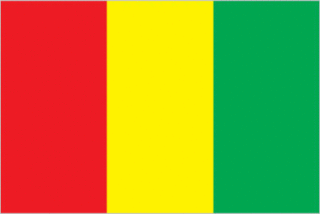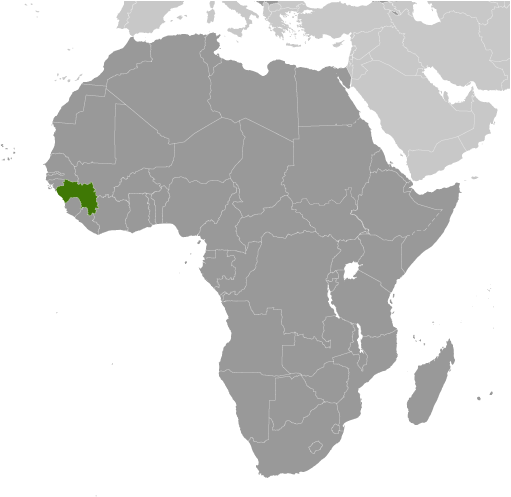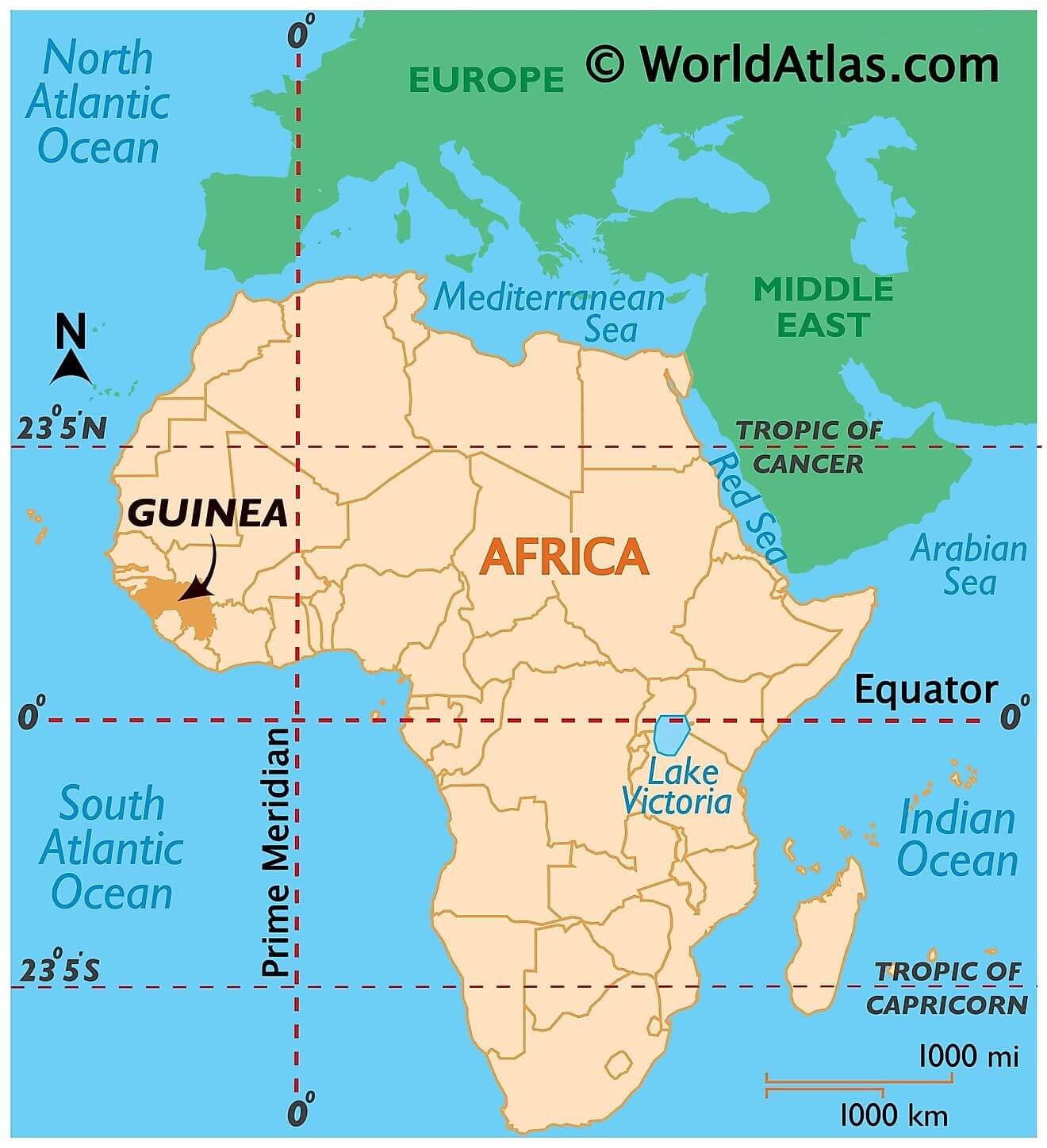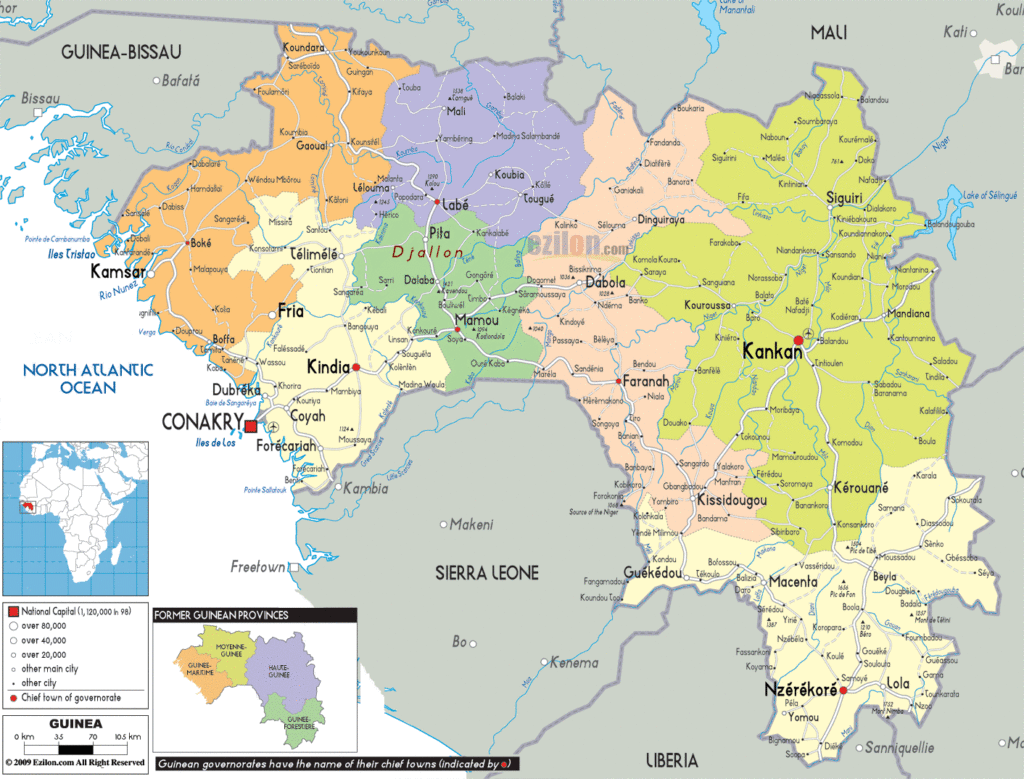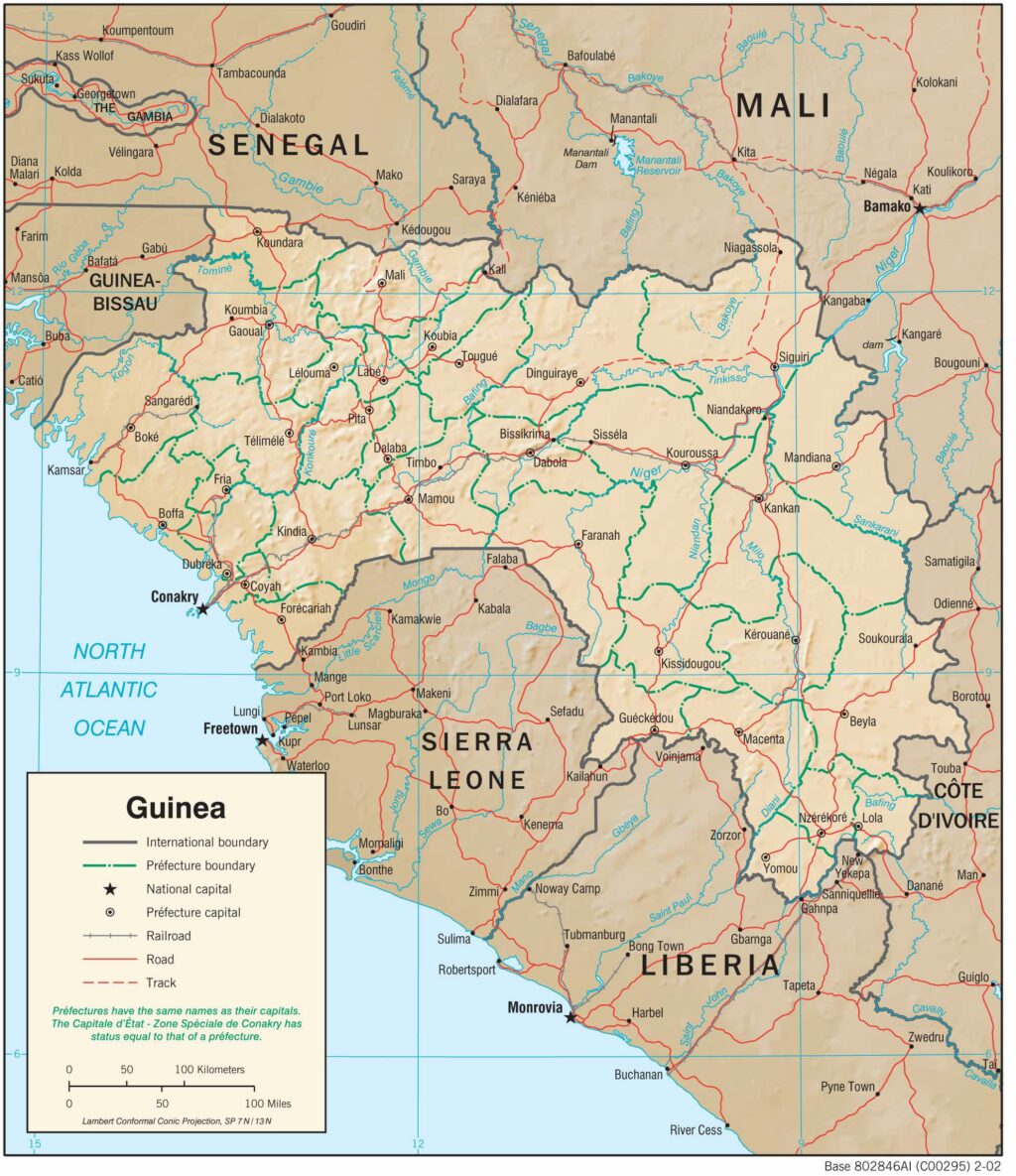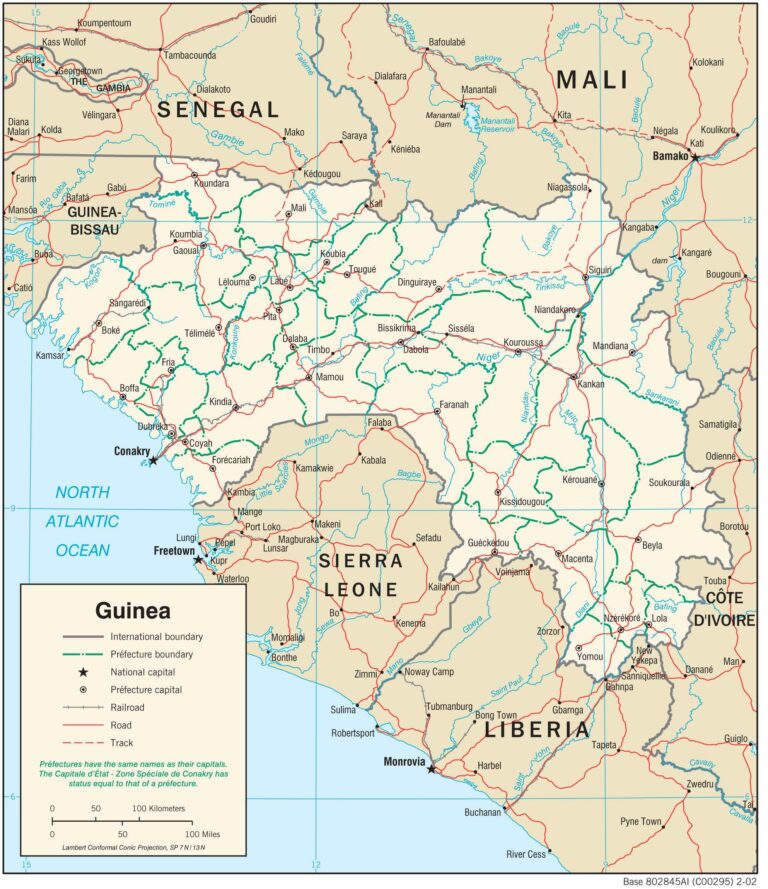The coastal country of Guinea in West Africa covers an area of 245,857 sq. km.
The country has been divided into four geographic regions. The Lower Guinea or the coastal plain that runs north to south along the coast of the country on the Gulf of Guinea. It features many drowned river valleys or rias and there are tidal estuaries and offshore islands.
The second region is the Fouta Djallon Highlands in Middle Guinea. The third region is Upper Guinea covered by savanna and finally Forest Guinea which is located to the southeast of the country and is covered by rainforests.
As visible on the physical map above, several rivers originate in the highlands of Guinea like the Niger and its tributaries, Bafing River, Milo River, Konkoure, and others.
Guinea’s highest point is Mont Nimba at 1,752 m and marked on the map by a yellow upright triangle in southern Guinea. The lowest point is the Atlantic Ocean at 0m.
Explore the Beauty of Guinea with this Interactive Map
Discover the wonders of Guinea with this interactive map. See its cities, towns, rivers, lakes and highways, as well as its satellite imagery and physical map of its topography and terrain. Get to know the beautiful country of Guinea like never before!
Online Interactive Political Map
Click on ![]() to view map in "full screen" mode.
to view map in "full screen" mode.
Guinea has seven regions which are Boke, Conakry*, Faranah, Kankan, Kindia, Labe, Mamou, and N’Zerekore. The national capital of Conakry is ranked as a special zone. The regions of Guinea are subdivided into 33 prefectures which, in turn, are divided into sub-prefectures.
With an area of 72,145 sq. km, Kankan is the largest region of Guinea and the most populous one as well.
Location Maps
Where is Guinea?
Guinea is located in Western Africa, bordering six other African countries. It has a coastline of 506 kilometers (314 mi) off the Atlantic Ocean. The capital and largest city of Guinea is Conakry, located along the west coast. Other major cities include Nzérékoré and Kankan. To the northwest is Guinea-Bissau, Senegal to the north, Mali to the northeast, Ivory Coast to the southeast, Liberia to the south, and Sierra Leone to the south.
High Definition Political Map of Guinea

History
The land that is now Guinea belonged to a series of African empires until France colonized it in the 1890s, and made it part of French West Africa. Guinea declared its independence from France on 2 October 1958. From independence until the presidential election of 2010, Guinea was governed by a number of autocratic rulers.
West African empires and kingdoms
What is now Guinea was on the fringes of some West African empires. The earliest, the Ghana Empire, grew on trade and ultimately fell after repeated incursions of the Almoravids. It was in this period that Islam first arrived in the region by way of North African traders.
The Sosso Empire (12th to 13th centuries) flourished in the resulting void, and the Mali Empire came to prominence when Soundiata Kéïta defeated the Sosso ruler Soumangourou Kanté at the Battle of Kirina, in c. 1235. The Mali Empire was ruled by Mansa (Emperors), including Kankou Moussa who made a hajj to Mecca in 1324. After his reign, the Mali Empire began to decline and was ultimately supplanted by its vassal states in the 15th century.
The Songhai Empire expanded its power from about 1460 and eventually surpassed the Mali Empire in both territory and wealth. It continued to prosper until a civil war, over succession, followed the death of Askia Daoud in 1582. The empire fell to invaders from Morocco at the Battle of Tondibi 3 years later. The Moroccans proved unable to rule the kingdom effectively and it split into smaller kingdoms.
After the fall of some of the West African empires, various kingdoms existed in what is now Guinea. Fulani Muslims migrated to Futa Jallon in Central Guinea, and established an Islamic state from 1727 to 1896, with a written constitution and alternate rulers. The Wassoulou or Wassulu Empire (1878–1898) was led by Samori Toure in the predominantly Malinké area of what is now upper Guinea and southwestern Mali (Wassoulou). It moved to Ivory Coast before being conquered by the French.
Colony
European traders competed for the cape trade from the 17th century onward and made inroads earlier. Slaves were exported to work elsewhere. The traders used the regional slave practices.
Guinea’s colonial period began with French military penetration into the area in the mid-19th century. French domination was assured by the defeat in 1898 of the armies of Samori Touré, Mansa (or Emperor) of the Ouassoulou state and leader of Malinké descent, which gave France control of what today is Guinea and adjacent areas.
France negotiated Guinea’s present boundaries in the late 19th and early 20th centuries with the British for Sierra Leone, the Portuguese for their Guinea colony (now Guinea-Bissau), and Liberia. Under the French, the country formed the Territory of Guinea within French West Africa, administered by a governor general resident in Dakar. Lieutenant governors administered the individual colonies, including Guinea.
In 1958, the French Fourth Republic collapsed due to political instability and its failures in dealing with its colonies, especially Indochina and Algeria. The French Fifth Republic gave the colonies the choice of autonomy in a new French Community or immediate independence, in the referendum of 28 September 1958. Unlike most other colonies, Guinea voted overwhelmingly for independence. It was led by Ahmed Sékou Touré whose Democratic Party of Guinea-African Democratic Rally (PDG) had won 56 of 60 seats in 1957 territorial elections. The French withdrew, and on 2 October 1958, Guinea proclaimed itself a sovereign and independent republic, with Sékou Touré as president.
The Washington Post observed the “brutal” French tearing down all that they considered their contributions to Guinea: “In reaction, and as a warning to other French-speaking territories, the French pulled out of Guinea over a two-month period, taking everything they could with them. They unscrewed lightbulbs, removed plans for sewage pipelines in Conakry, the capital, and even burned medicines rather than leave them for the Guineans.”
Post-colonial (1958–)
Subsequently, Guinea aligned itself with the Soviet Union and adopted socialist policies. It then moved towards a Chinese model of socialism. It continued to receive investment from capitalist countries, such as the United States. By 1960, Touré had declared PDG the country’s only legal political party, and for the next 24 years, the government and PDG were one. Touré was re-elected unopposed to 4 7-year terms as president, and every 5 years voters were presented with a single list of PDG candidates for the National Assembly. Advocating a hybrid African Socialism domestically and Pan-Africanism abroad, Touré became a polarising leader, with his government becoming intolerant of dissent, imprisoning thousands, and stifling the press.
Throughout the 1960s, the Guinean government nationalised land, removed French-appointed and traditional chiefs from power, and had strained ties with the French government and French companies. Touré’s government relied on the Soviet Union and China for infrastructure aid and development, and much of this was used for political and not economic purposes, such as the building of stadiums to hold political rallies.
On 22 November 1970, Portuguese forces from neighbouring Portuguese Guinea staged Operation Green Sea, a raid on Conakry by several hundred exiled Guinean opposition forces. Among their goals, the Portuguese military wanted to kill or capture Sekou Touré due to his support of PAIGC, an independence movement and rebel group that had carried out attacks inside Portuguese Guinea from their bases in Guinea. After some fighting, the Portuguese-backed forces retreated, having freed several dozen Portuguese prisoners of war that were being held by PAIGC in Conakry, and without having ousted Touré. In the years after the raid, purges were carried out by the Touré government, and at least 50 thousand people were killed. Others were imprisoned and faced torture. Some foreigners were forced to leave the country, after having had their Guinean spouse arrested and their children placed into state custody.
Guinea was elected as a non-permanent member of the UN Security Council 1972–73.
In 1977, a declining economy, mass killings, a stifling political atmosphere, and a ban on all private economic transactions led to the Market Women’s Revolt, a series of anti-government riots started by women working in Conakry’s Madina Market. This prompted Touré to make major reforms. Touré vacillated from supporting the Soviet Union to supporting the United States. The late 1970s and early 1980s saw some economic reforms, while Touré’s centralized control of the state remained. In the relationship with France, after the election of Valéry Giscard d’Estaing as French president, trade increased and the 2 countries exchanged diplomatic visits.
Sékou Touré died on 26 March 1984, after a heart operation in the United States, and was replaced by Prime Minister Louis Lansana Beavogui, who was to serve as interim president, pending new elections. PDG was due to elect a new leader on 3 April 1984. Under the constitution, that person would have been the only candidate for president. Hours before that meeting, Colonels Lansana Conté and Diarra Traoré seized power in a bloodless coup. Conté assumed the role of president, with Traoré serving as prime minister, until December.
Conté denounced the previous regime’s record on human rights, releasing 250 political prisoners and encouraging approximately 200 thousand more to return from exile. He made explicit the turn away from socialism.
In 1992, Conté announced a return to civilian rule, with a presidential poll in 1993, followed by elections to parliament in 1995 (in which his party—the Party of Unity and Progress—won 71 of 114 seats.) In September 2001, the opposition leader Alpha Condé was imprisoned for endangering state security and pardoned 8 months later. Subsequently, he spent time in exile in France.
In 2001, Conté organized and won a referendum to lengthen the presidential term, and in 2003, began his third term after elections were boycotted by the opposition. In January 2005, Conté survived a suspected assassination attempt while making a public appearance in the capital of Conakry. His opponents claimed that he was a “tired dictator”, whose departure was inevitable, whereas his supporters believed that he was winning a battle with dissidents. According to Foreign Policy, Guinea was in danger of becoming a failed state.
In 2000, Guinea suffered from the instability which had blighted the rest of West Africa, as rebels crossed the borders with Liberia and Sierra Leone. It seemed that the country was headed for civil war. Conté blamed neighbouring leaders for coveting Guinea’s natural resources, and these claims were denied. In 2003, Guinea agreed to plans with her neighbours to tackle the insurgents. The 2007 Guinean general strike resulted in the appointment of a new prime minister.
Conté remained in power until his death on 23 December 2008. Several hours after his death, Moussa Dadis Camara seized control in a coup, declaring himself head of a military junta. Protests against the coup became violent, and 157 people were killed when, on 28 September 2009, the junta ordered its soldiers to attack people gathered to protest Camara’s attempt to become president. The soldiers went on a rampage of rape, mutilation, and murder, which caused some foreign governments to withdraw their support for the new regime.
On 3 December 2009, an aide shot Camara during a dispute over the rampage in September. Camara went to Morocco for medical care. Vice-president (and defense minister) Sékouba Konaté flew from Lebanon to run the country. After meeting in Ouagadougou on 13 and 14 January 2010, Camara, Konaté and Blaise Compaoré, President of Burkina Faso, produced a formal statement of 12 principles promising a return of Guinea to civilian rule within 6 months. The presidential election of 27 June brought allegations of fraud, and a second election was held on 7 November. Voter turnout was “high”, and the elections went “relatively smoothly”. Alpha Condé, leader of the opposition party Rally of the Guinean People (RGP), won the election, promising to reform the security sector and review mining contracts.
In February 2013, political violence erupted after street protests over transparency of upcoming May elections. The protests were fueled by the opposition coalition’s decision to step down from the elections, in protest of the lack of transparency in the preparations for elections. 9 people were killed during the protests, and around 220 were injured. Some deaths and injuries were caused by security forces using live ammunition on protesters. The violence led to ethnic clashes between the Malinke and Fula, who supported and opposed President Condé, respectively. On 26 March 2013, the opposition party backed out of negotiations with the government over the election, saying that the government had not respected them, and had broken all agreements.
On 25 March 2014, the World Health Organization stated that Guinea’s Ministry of Health had reported an outbreak of Ebola virus disease in Guinea. This initial outbreak had 86 cases, including 59 deaths. By 28 May, there were 281 cases, with 186 deaths. It is believed that the first case was Emile Ouamouno, a 2-year-old boy in the village of Meliandou. He fell ill on 2 December 2013 and died on 6 December. On 18 September 2014, 8 members of an Ebola education health care team were murdered by villagers in the town of Womey. As of 1 November 2015, there had been 3,810 cases and 2,536 deaths in Guinea.
The 2019–2020 Guinean protests were a series of violent protests and mass civil unrest against the rule of Alpha Conde that broke out on October 14, 2019, against constitutional changes. More than 800 were killed in clashes. After the 2020 Guinean presidential election, Alpha Condé’s election to a third term was challenged by the opposition, who accused him of fraud. Condé claimed a constitutional referendum from March 2020 allowed him to run despite the 2-term limit.
On 5 September 2021, after hours of gunfire near the presidential palace, Lieutenant Colonel Mamady Doumbouya seized control of state television and declared that President Alpha Conde’s government had been dissolved and the nation’s borders closed. By the evening, the putschists declared control of all Conakry and the country’s armed forces. According to Guinée Matin, by 6 September the military fully controlled the state administration and started to replace the civil administration with its military counterpart. The United Nations, European Union, African Union, ECOWAS (which suspended Guinea’s membership) and La Francophonie denounced the coup, and called for President Condé’s unconditional release. Similar responses came from some neighboring and Western countries (including the United States), and from China (which relies on Guinea for half of its aluminum ore, facilitated by its connections to President Condé). Despite these, On 1 October 2021, Mamady Doumbouya was sworn in as interim President.
Physical Map of Guinea

